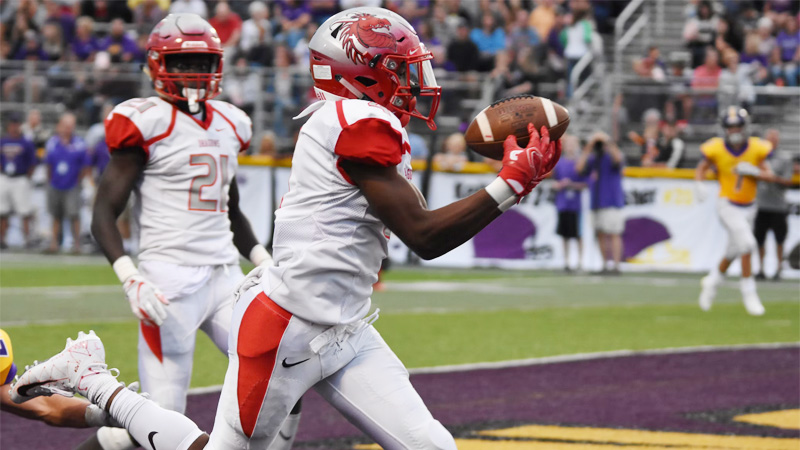American football, a sport steeped in tradition and strategy, captivates millions with its thrilling displays of athleticism and teamwork.
At the heart of this high-octane game lies the touchdown—a term that resonates with fans and players alike. But what is a touchdown in football, and why is it such a pivotal moment in every football game?
In this blog post, we will unravel the core concept of touchdowns in American football.
We’ll explore its fundamental requirements, the strategies employed to achieve them, and the traditions that make touchdown celebrations an integral part of the sport’s identity.
Whether you’re a seasoned football enthusiast or a newcomer curious about the game, understanding touchdowns is key to appreciating the excitement and drama that unfolds on the gridiron. Stay focused.
What Is A Touchdown In Football?
A touchdown in football is a fundamental scoring play that occurs when an offensive player successfully carries or catches the ball into the opposing team’s end zone.
It is the primary way to earn points in American and Canadian football. To score a touchdown, a player must break the plane of the opponent’s goal line while in possession of the ball.
This act not only earns the team six points but also grants them the opportunity to try for an extra point or a two-point conversion, which can add to their overall score.
Touchdowns are the most celebrated and pivotal moments in a football game, often involving skillful passes, powerful runs, or precise catches, and they play a crucial role in determining the outcome of matches.
Touchdowns vs. Other Scoring Plays
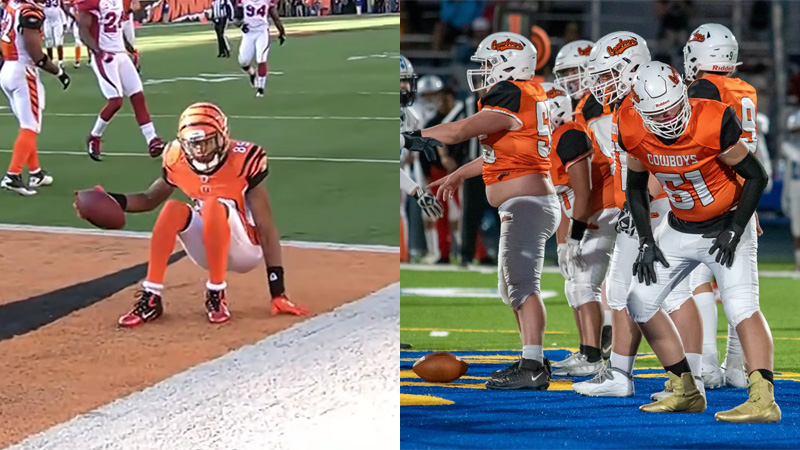
In American football, touchdowns are the most valuable scoring plays and are distinct from other scoring methods like field goals and extra points.
Here’s a comparison between touchdowns and these other scoring plays:
Touchdown
- Worth 6 points.
- Scored by advancing the ball across the opponent’s goal line while in possession of the ball.
- Can be scored by running the ball into the end zone or catching a pass within the end zone.
- After a touchdown, the scoring team has the option to attempt an extra point (1 or 2 points) or a two-point conversion (2 points) for additional points.
- Often involves more extensive offensive efforts, such as long passes, intricate running plays, and successful drives down the field.
Field Goal
- Worth 3 points.
- Scored by successfully kicking the ball through the opponent’s goalposts during a designated field goal attempt.
- Typically attempted when a team is within kicking range but unable to reach the end zone for a touchdown.
- Requires a skilled kicker and a precise snap and hold.
Extra Point
- Worth 1 point (kicked) or 2 points (run or pass).
- Attempted after a touchdown, the team can choose to kick the ball through the goalposts for 1 point or run/pass the ball into the end zone for 2 points.
- Extra points are relatively short-range plays and are considered high-percentage scoring opportunities.
Touchdowns are the most coveted and valuable scoring plays in American football, representing a team’s successful advancement into the opponent’s end zone.
Fundamental Requirement of Touchdown
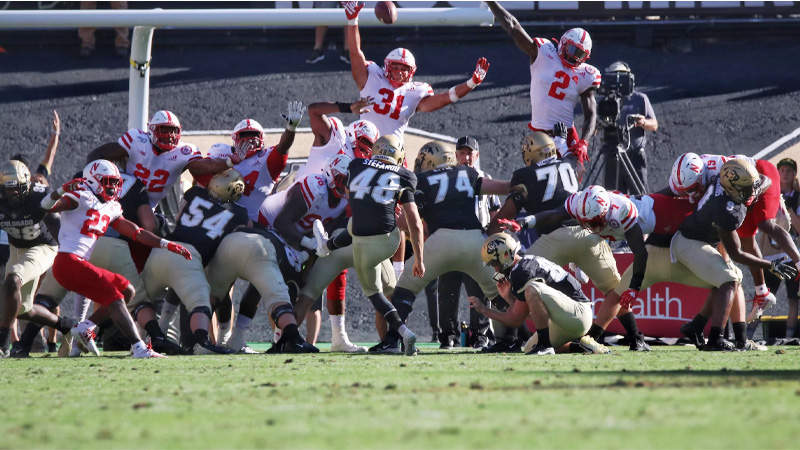
The fundamental requirement for a touchdown in American football is to advance the ball into the opponent’s end zone while in possession of the ball.
Here are the key elements that must be met for a touchdown to be scored:
Possession of the Ball
A player or team must have legal possession of the football. This means they must have control of the ball through a catch, a carry, or any other legal means recognized by the rules of the game.
Advancement Across the Goal Line
The player in possession of the ball must carry, run, or catch the ball in a manner that allows them to break the plane of the opponent’s goal line.
The plane is an imaginary line that extends vertically from the goal line.
Contact with the End Zone
The ball carrier must make contact with the end zone, which is the area at the far end of the field marked by the goal line and the boundary lines.
Control and Possession
Throughout the process of advancing the ball into the end zone, the player must maintain control and possession of the ball. This means they cannot fumble or lose control of the ball while crossing the goal line.
Both Feet Inbounds (if applicable)
In college football and professional football, if a player catches a pass while in the air, they must have both feet touch the ground inbounds while maintaining possession of the ball to score a touchdown.
Once these fundamental requirements are met, a touchdown is awarded, and the scoring team earns six points.
Offensive Strategies for Scoring a Touchdown
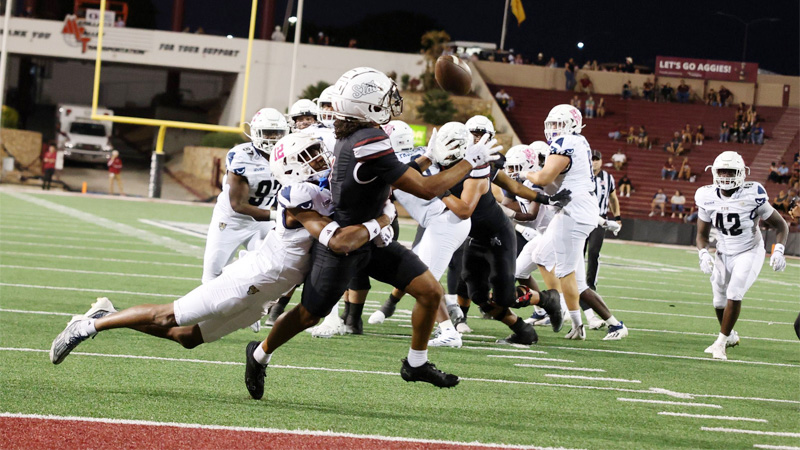
Scoring a touchdown in American football requires effective offensive strategies. Here are some key offensive strategies commonly employed to score touchdowns:
Passing Plays
- Utilize the quarterback’s arm strength and accuracy to throw deep passes or short, precise throws.
- Employ wide receivers, tight ends, and running backs as pass-catching targets.
- Execute plays like slant routes, post routes, fade routes, and screen passes to exploit the defense’s weaknesses.
Running Plays
- Establish a strong running game by handing off the ball to running backs.
- Employ offensive linemen to create running lanes and block defenders.
- Use misdirection plays like counters, sweeps, and draws to confuse the defense and gain yardage.
Play Action
- Fake a running play to draw in defenders and then execute a pass play.
- Confuse the defense by making them guess whether the offense will run or pass.
- Often used near the opponent’s goal line to target open receivers.
Red Zone and Goal Line Plays
- Implement specific plays designed for the short field when approaching the end zone (red zone offense).
- Utilize power running plays, quick passes, and fade routes in goal-line situations.
Option Offense
- Employ a quarterback who can both run and pass effectively.
- Use read-option plays, where the quarterback decides whether to keep the ball or hand it off based on the defense’s actions.
- Confuse the defense by presenting multiple threats on each play.
Screen Plays
- Execute screen passes to running backs or wide receivers to take advantage of over-aggressive defenses.
- Use blockers to set up a path for the ball carrier, allowing them to gain significant yardage.
Trick Plays
- Occasionally incorporate trick plays like flea flickers, reverses, or double passes to catch the defense off guard.
- Trick plays can create opportunities for big gains and touchdowns.
Two-Minute Drill
- Employ a hurry-up offense, particularly in late-game situations, to conserve time and march down the field quickly.
- Utilize no-huddle play-calling and short, efficient passes to keep the defense on its heels.
Exploiting Matchups
- Identify and exploit favorable matchups between offensive players and defensive opponents.
- Target weaker defenders or exploit size and speed advantages in one-on-one situations.
Successful touchdown drives often involve a combination of these offensive strategies, adaptability to the opponent’s defensive schemes, and well-executed plays.
Traditions and Celebrations Surrounding Touchdowns
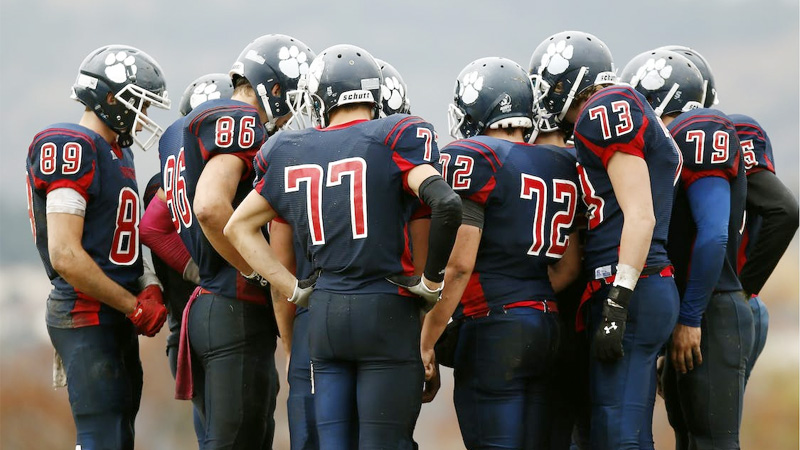
Touchdowns in American football are often celebrated with enthusiasm, and they have given rise to various traditions and celebrations that are beloved by players and fans alike.
Here are six common traditions and celebrations surrounding touchdowns:
Spike the Ball
One of the most iconic touchdown celebrations is when the player who scored spikes the football into the ground in the end zone.
This high-energy move is a way to release excitement and is often accompanied by cheering from teammates.
Dance and Celebratory Gestures
Players frequently showcase their creativity by choreographing dances or celebratory gestures in the end zone.
These dances can be elaborate or simple, and they often become signature moves associated with the player.
Group Celebrations
Touchdowns often bring teammates together for group celebrations.
Players might gather for coordinated dances or celebrations that involve several members of the offense. These moments promote team unity and camaraderie.
The Lambeau Leap
A unique tradition in Green Bay, Wisconsin, at Lambeau Field, is the “Lambeau Leap.”
After scoring a touchdown, Packers players leap into the stands to celebrate with the fans. It’s a cherished tradition that brings the players closer to the community.
Spiking or Giving the Ball to a Fan
Some players choose to give the football to a lucky fan in the stands as a memento. This act of generosity connects players with their supporters and adds to the excitement of scoring.
Kneel and Prayer
Many players choose to mark their touchdowns with a moment of reflection and prayer. This quieter celebration is a personal expression of gratitude for their success on the field.
Spike the Pylon
In recent years, some players have developed a trend of spiking the pylon (the orange markers at the corners of the end zone) after scoring a touchdown. This adds a unique and memorable touch to the celebration.
These touchdown traditions and celebrations not only entertain fans but also allow players to express themselves and build connections with their teams and supporters.
Misunderstandings About Scoring Touchdowns
There can be several misunderstandings or misconceptions about scoring touchdowns in American football. Here are some common ones:
Crossing the Plane
Some people believe that the ball needs to completely cross the goal line for a touchdown to be scored.
In reality, as long as any part of the ball breaks the vertical plane extending up from the goal line, it is considered a touchdown.
Two Feet In Bounds
While this is true for receptions inbounds, when it comes to scoring a touchdown, a player only needs one foot inbounds (or no feet if they’re diving from out of bounds) after catching the ball in the end zone.
End Zone Size
There’s a misconception that all end zones in American football are the same size. In reality, end zone lengths can vary in different stadiums and leagues.
The NFL’s standard end zone depth is 10 yards, but it may be shorter in other leagues or college football.
Scoring from Anywhere on the Field
Not every play that ends in the end zone results in a touchdown. To score a touchdown, a player must legally possess the ball while crossing the opponent’s goal line.
Simply carrying or catching the ball in the end zone without breaking the plane doesn’t count as a touchdown.
Touchdown and Field Goal Points
Some people confuse the number of points awarded for touchdowns (6 points) with field goals (3 points). Touchdowns are worth more than field goals, making them a more valuable scoring play.
Infinite Points
There’s a misunderstanding that touchdowns can result in an infinite number of points.
In reality, a touchdown is worth 6 points, and the extra point or two-point conversion that follows can add a maximum of 1 or 2 points, respectively.
Defensive Touchdowns
Touchdowns are not exclusive to the offense. If a defensive player intercepts the ball or recovers a fumble and runs it into the opposing team’s end zone, it’s also considered a touchdown.
This can be confusing for some who associate touchdowns primarily with offensive plays.
The specific rules and nuances of scoring touchdowns is important in American football, as these points often play a pivotal role in determining the outcome of games.
FAQs
What is a touchdown in American football?
A touchdown in American football is a scoring play worth 6 points. It occurs when an offensive player carries or catches the ball into the opponent’s end zone while in possession of the ball, breaking the plane of the goal line.
How can a team earn additional points after scoring a touchdown?
After scoring a touchdown, a team has the option to attempt an extra point (1 or 2 points) by kicking the ball through the goalposts or a two-point conversion (2 points) by running or passing the ball into the end zone.
Does the entire football need to cross the goal line for a touchdown to count?
No, only a portion of the football needs to break the vertical plane extending up from the goal line to score a touchdown. The entire ball doesn’t have to cross the line.
Can a defensive player score a touchdown?
Yes, a defensive player can score a touchdown by intercepting the ball or recovering a fumble and then carrying it into the opposing team’s end zone.
How does the end zone size vary in American football?
While the standard NFL end zone depth is 10 yards, it can vary in different leagues and stadiums.
College football and other levels of play may have different end zone dimensions, but they still function in the same way for scoring touchdowns.
Wrapping Up
In the world of American football, a touchdown isn’t just a mere score; it’s a culmination of skill, strategy, and teamwork. It’s the moment that electrifies stadiums, unites fans, and immortalizes players in the annals of sports history.
This simple act of carrying or catching a ball across the goal line holds the power to turn the tide of a game, to inspire and entertain, and to keep generations of fans coming back for more.
As we’ve delved into the essence of touchdowns, we’ve discovered they are the beating heart of a sport that continues to capture our imagination and unite us in our love for the game of American football. Thank you.

